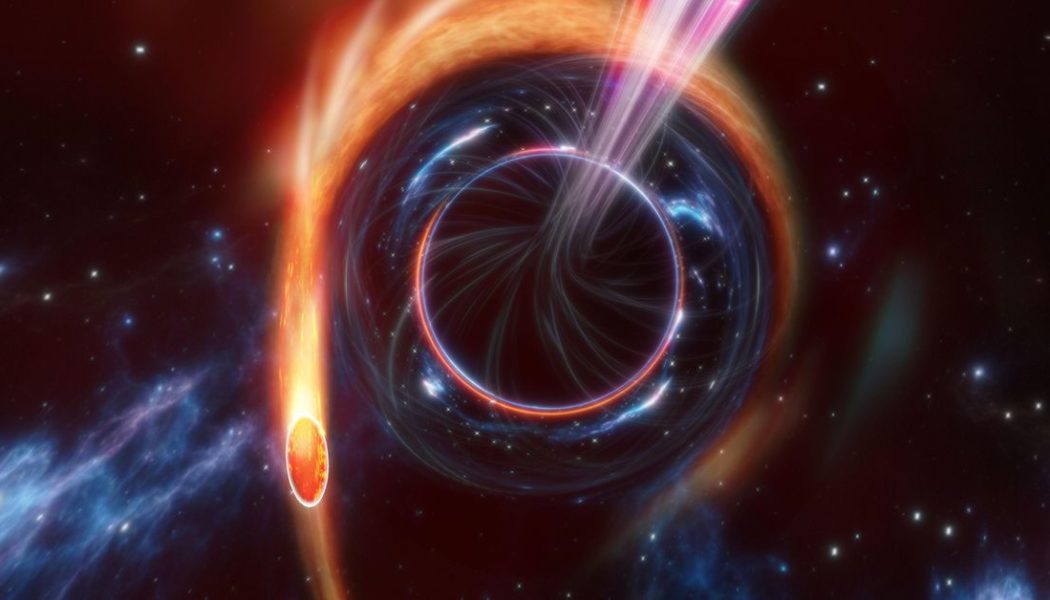/cdn.vox-cdn.com/uploads/chorus_asset/file/24245965/A3_Tidal_Disruption_Graphic.jpeg)
It was an event not seen in more than a decade: a sudden flash of energy launched out from the center of a distant galaxy, bright enough to be visible from 8.5 billion light-years away. With a burst of light equivalent to more than 1,000 trillion suns, the flash was first detected by the Zwicky Transient Facility, a survey of the entire night sky conducted from the Palomar Observatory in California.
“On Valentine’s Day this year, we found a source that was puzzling. It was just weird!” Igor Andreoni of the University of Maryland, lead author of one of two papers about the event, told The Verge. “And weird is good in science. It means it’s something you can learn from.”
Within days, astronomers around the world turned their telescopes toward the flash, observing it in X-ray, radio, and other wavelengths. It was extraordinarily bright and was similar to a gamma-ray burst — a type of bright flash usually detected by gamma ray or X-ray telescopes. But this one had been spotted by an optical telescope.
The tremendous brightness of the flash led astronomers to conclude that it must have been caused by a star being torn apart. A star had wandered too close to the supermassive black hole at the heart of a galaxy and been shredded by the gravitational forces. “It can completely rip apart the star. It’s literally pulled and stretched until it can’t stand together anymore,” Andreoni explained. This is called a tidal disruption event, and astronomers have spotted dozens of these events over recent years.
“Weird is good in science. It means it’s something you can learn from”
What is unusual about this particular event is that it created a tremendous jet of energy, with material being thrown out from the black hole’s poles at close to the speed of light. “We don’t know why, but sometimes a very powerful jet of material is launched when the star is disrupted,” Andreoni said. This jet is thought to have been especially bright because it is pointed directly at Earth, making it both appear brighter and be visible across a broader part of the electromagnetic spectrum.
To spot dramatic transient events like these, astronomers need telescopes that continually scan as much of the sky as possible and which flag any sudden changes in brightness — like the Zwicky Transient Facility. But there are thousands of changes in brightness observed every night, so this mountain of data needs to be refined to unearth the most interesting objects. Andreoni’s group works on sifting through this data to find very fast events in the optical wavelength.
Sudden changes in brightness could potentially be caused by a supernova or by two neutron stars merging. Further observations are needed to understand the specific event that triggered the flash. A supernova, for example, brightens over a period of weeks, which is extremely fast by astronomical standards. But this particular event brightened even faster than that, within a few hours or days. That made it of immediate and pressing interest.
The group flagged this flash to the international community, encouraging researchers who worked using telescopes operating in other wavelengths like radio or X-ray to observe it, too. In total, 21 telescopes contributed data on the event. “When all the pieces of the puzzle were acquired and put together, this picture emerged which was just astonishing,” Andreoni said. “We were not expecting to find such a rare source, and definitely not in the optical.”
Of the stars that are ripped apart by black holes, only around 1 percent seem to produce these powerful jets, but researchers still aren’t sure exactly why. As the star is pulled apart and its material is pulled in toward the black hole, the energy of this matter is converted into light. It’s theorized that the magnetic fields and spin of the black hole could act together to send material shooting out from its poles — like a tube of paint squeezed in the middle until material flies out of either end.
“We’re talking about thousands of times the mass of the Earth that is pulled apart and spun up and launched at close to the speed of light. It’s a really unique opportunity to study something that is impossible to reproduce on Earth,” Andreoni said.
This was the first time that such a jet had been detected in the visible light part of the electromagnetic spectrum, also known as the optical wavelength. Previously, jets from around black holes had been detected by looking at X-rays, gamma rays, and radio waves.
This both tells astronomers something about the environment around the black hole — that it is not that dense because it allowed optical light to pass through — and shows that looking in the optical range could be a useful way to spot these extreme events in the future.
“We’re talking about thousands of times the mass of the Earth that is pulled apart and spun up and launched at close to the speed of light.”
The need for telescopes to respond quickly to such events is also creating an impetus for greater flexibility in telescope design and planning. Telescopes like Hubble or James Webb are vastly oversubscribed, meaning many more researchers apply for time on the telescope than it is possible to accommodate. That’s why observing time is meticulously planned out years in advance and every last minute of observation time is filled as much as possible. But there’s also a need for telescopes that can respond to rare events within hours or even minutes.
It’s hard to safely and quickly change the direction of a space-based telescope, so Hubble and the James Webb Space Telescope only occasionally contribute to this kind of research. But recently built ground-based telescopes, like the MASTER network or the GROWTH-India telescope, specialize in scanning the sky for gamma-ray events and immediately and autonomously moving to observe them.
And there’s always the option of a human-based intervention. “Sometimes you literally have to call people up and say, ‘Hey, can you please point the telescope at these or those coordinates?’” Andreoni said. In other cases, researchers submit requests through online systems to make observations during available moments. There’s increasing interest in considering how telescopes can respond to these brief and rare but scientifically important events.
Both the international cooperation between researchers working with different telescopes and the ability of those telescopes to respond rapidly were essential for making this breakthrough in black hole observations, Andreoni said. “This was extremely important for this kind of discovery. If we couldn’t do it with any telescope, we would have not realized that we were sitting on such a big discovery.”









